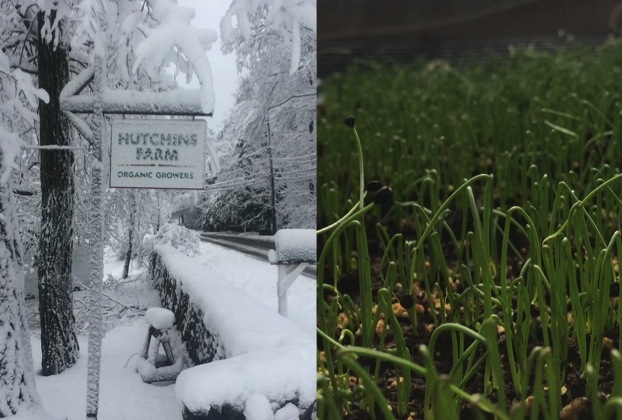With winter parked stubbornly over the region, the arrival of the vernal equinox seems somehow premature. The sun traces a longer, higher arc each day, the angle and quality of the light whispers of warm breezes riffling newly unfolded leaves, but buds remain firmly clenched against the cold, and wind-scoured snowfields persist where we had hoped to see slowly greening fields exhaling into the bright spring morning. Hopeful birds squabble, and speak of spring and summer as they scrape a meager living from last year’s leftovers, impatient like all of us for the world to come to life again.
There was a brief moment about two weeks ago as I contemplated the newly thawed ground, the first garlic leaves poking out from their straw blanket, the doughty parsnips sending up tiny new leaves, with ravenous deer pawing and biting at the knobby white roots, accepting mouthfuls of mud for a taste of the super sweet, newly thawed parsnips, that I thought spring had arrived early. I’m glad that my cautious nature (AKA a tendency to procrastinate) prevailed. With luck and some cooperative weather, our first forays into the fields–to seed the peas and spinach, plow and fertilize the areas that will be planted to other early crops, to dig the patient parsnips—will happen right on schedule, around the middle of April. I’m often asked if climate change has affected when I plant and what I plant, and I suppose to some degree it does, but it seems like the most salient feature of climate change is violent unpredictability rather than some gentle warming and lengthening of the season. So I’ll stick with my planting dates for the moment, and maybe take a few side bets on unusual crops or additional plantings into the fall.
Farm activities this time of year include pruning apples and blueberries, machinery and building repair and maintenance and seeding and transplanting in the greenhouse. The pace is measured and deliberate, though repeat nor’easters cause a few stumbles. Within a few weeks, the tempo of the season’s music will pick up, and we, the dancers, will begin our increasingly furious dance, familiar and brand new at the same time. More stumbles will doubtless ensue, but hopefully we know our steps well enough that the humble magic of seed and soil and water and work will result in another season of plentiful harvests.
For our gardeners, our 2018 plant catalogue will be on the website soon, so keep a lookout on our social media and website for the announcement of its arrival. The first harvest, mentioned above, is really a holdover from last season: parsnips, sweetened by a long winter sleep. Parsnips are a problematic crop, with their strange-shaped, flaky seeds, which require up to three weeks to germinate (emerging like late risers among the newly germinated carpet of weeds that sprout more promptly), the roots requiring another four months after that to grow to maturity. The amount of effort required to raise a crop of parsnips is out of proportion to the economic value of the crop, but the value of the first freshly harvested produce to winter-weary folks can’t be calculated on a balance sheet. We eagerly await the time when we can get in the field and harvest each year, and hope to have parsnips for sale on the porch, self-serve style, beginning in early to mid-April.
Alongside the parsnips, we’ll have the usual bagged compost and potting soil for gardeners, to be followed by the earliest garden plants (spinach, lettuce, onions) in late April or early May. Also arriving in late April, if history is any guide, will be the first asparagus of the season, delicious harbinger of all the fruits and veggies that follow.
As we await these mundane yet extraordinary developments, those who wish to get a more complete understanding of the historical and current role of agriculture in the town and the region may wish to attend the Concord Ag Committee’s Spring Forum, featuring a presentation by Brandeis professor Brian Donahue, entitled ‘Wildlands, Woodlands, Farmland and Community: Farming in Concord and New England’, to be held on Thursday, March 29th at 7PM at the Willard School Auditorium.
Check our website for the freshest, most up-to-date information about what we have available and what may be coming soon. We hope you all have an opportunity to come visit this season, whether it be once or many times, to restore and refresh a connection with a place and community through the communion of good, healthy food.
Happy first day of “Spring”!
-Brian and the Hutchins Farm Crew
 From left to right: Snowstorm on March 13th, Onions in the prop house
From left to right: Snowstorm on March 13th, Onions in the prop house
